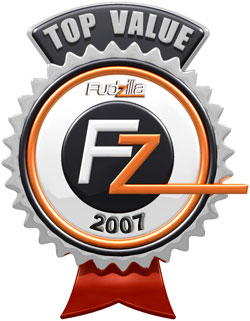After playing with it for a few days we are finally ready to tell you a bit about Jetway P965 motherboard.
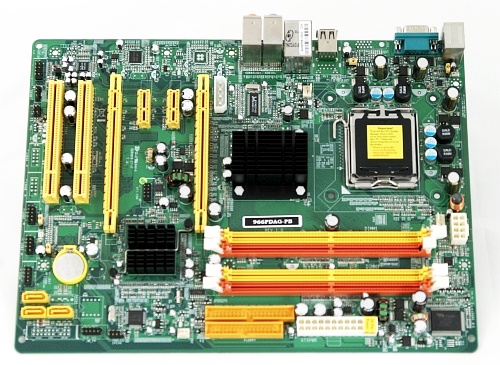
This is how the board looks like.
Features:
Intel P965/iCH8
4-phase VRM
Realtek ALC888
Realtek RTL8111B PCIe network MAC
Fintec F71882FG multi I/O controller
Realtek RTM875T-509 clock generator
JMicro JM20330 IDE single master controller
passive cooling of chipsets
2Mb BIOS, version A03, A06, beta
Mainboard Revision: 2.0
Slots:
1x PCIe x16, 1x PCIe x16 @ x4 speed
2x PCIe x1
2x PCI
Memory:
2x Dual-Channel DDR2-slots for PC2-6400U memory up to 8GB
Storage:
3-Port SATA II
1-Port IDE
Backpanel ports:
1x PS/2 keyboard
1x PS/2 mouse
1x Gb LAN
4x USB 2.0
1x COM
7.1 Audio analog
Accessories:
1x SATA cable
1x IDE cable

BIOS features:
Bus Speeds: Auto, 200MHz to 600MHz in 1MHz increments
Memory Ratios: Auto, fixed ratios: 1:1, 1:1.2, 1:1.25, 1:1.5, 1:1.6, 1:1.66 depending on FSB
DRAM command rate: Auto, 1T, 2T
DRAM timing control: Auto, manual
PCIe Frequency: Auto, 100 to 150 MHz in 1MHz increments
CPU Clock Multiplier: Auto, manual
Core 2 Duo: 6x-11x in 1X increments - Core 2 Duo, downwards unlocked
Core 2 Extreme: 6x-16X, downwards unlocked
CPU Voltage: auto, 0.83125V to 1.7000V in 0.0125V increments
CPU 7shift: 50mV to 300mV in 50mV increments
DRAM Voltage: Auto, 1.50V to 2.20V in 0.03V increments
FSB Termination Voltage: Auto, 1.20V to 1.50V in 0.03V increments
North Bridge Voltage: Auto, 1.16V to 1.62V in 0.03V/0.04V increments
South Bridge Voltage: Auto, 1.39V to 1.96V in 0.03V-0.05V increments
Layout:
Jetway provdes a board with a really nice layout. colors will hurt an average europen eyes but all connectors are layed out to make the access as easy as possible. The voltage regulator is an 4-phase analogue part, although we would have prefered an all solid design, it is sufficent and stable in operation. The power connector is positioned under the memory slots. The 8-pin CPU power connector is well placed on the outer edge of the board next to the memory sockets. The CPU area is clear, so mounting big coolers is easy. During operation there was no noticable VDrop, you don't have to worry about stability.
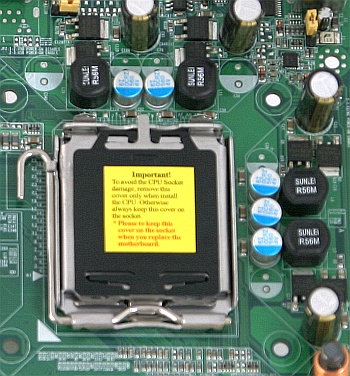
The iCH8 supports four SATA II ports, but lacks support for IDE. For reasons unknown, Jetway only soldered 3 SATA connectors, the 4th wouldn't have hurt. Of course we would have prefered if Jetway has decided to use the iCH8R, for the more enthusiast people this would have been the better choice. A JMicro single IDE controller provides connectivity to only one IDE drive, which has to be jumpered as master. You can not install a second IDE drive.
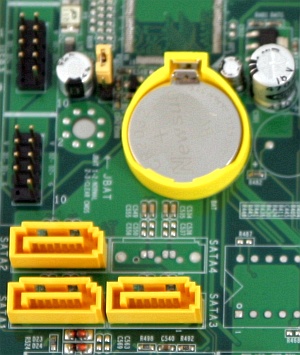
Network connectivity is provided by one Realtek RTL8111B via PCIe. Firewire is missing on this board, but there is an other board model called 966PDAGE which includes firewire support. Nowadays firewire looses importance over USB 2.0, so we can live without it easily. The audio codec is a standard Realtek ALC888 which is sufficient for common user. Gamers will install an extra soundcard anyways. Multi I/O and VRM controll is provided by the Fintec chip, also common used by MSI.
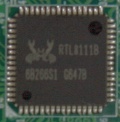
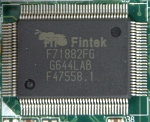
The case connectors are not colour coded, but described on the board itself.
The configuration of the slots is not perfect, because a 3rd PCI slot would be the nice idea, because PCIe x1 cards are still not common today.
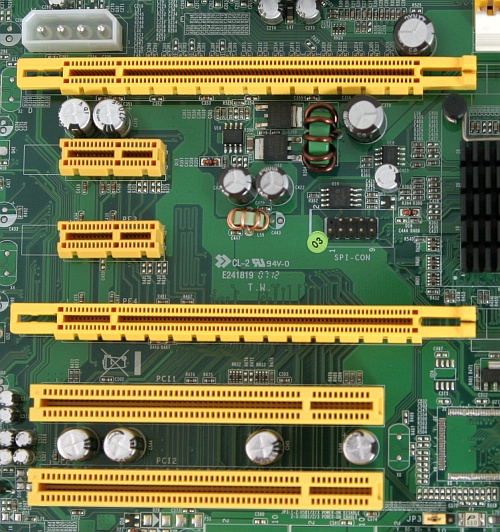
The chipsets are covered by simple aluminium heatsinks, but they did not get hot.
Overclock/BIOS:
This is a budget board, so do not expect miracles. We managed to get a stable 350MHz FSB, so even the new CPUs with 333MHz FSB will fit with overclocked settings.
We had troubles to use PC2-6400U memory kits with overclocked FSB, we guess the timings inside the chipset were set too high for higher FSB or an FSB-strap did not kick in. After four weeks of explaining to the Jetway support they finally understood the problem and fixed this issue.
The board run without problems when memory was set to 1000MHz.
The BIOS setting for memory setting is confusing, because you have to set DDR2-667 to get DDR2-800 with FSB 320, we would have prefered memory multiplicators.
When you want to run the board with FSB333 we recommand to increase the northbridge voltage slightly to insure stable operation.
Here some BIOS pictures:
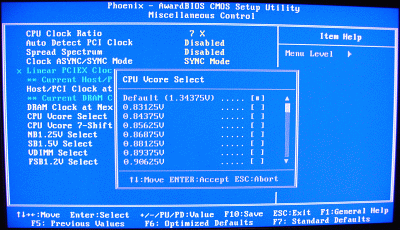
Click here for bigger version
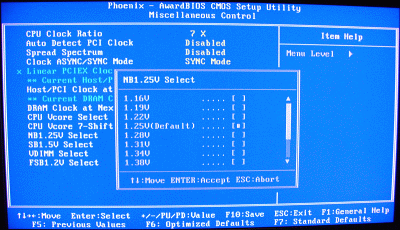
Click here for bigger version
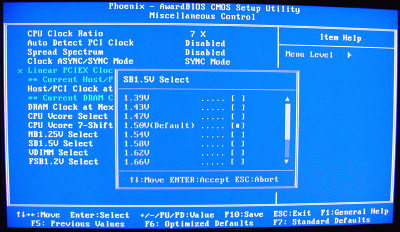
Click here for bigger version
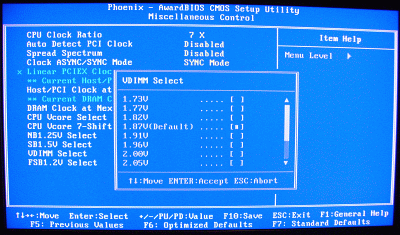
Click here for bigger version
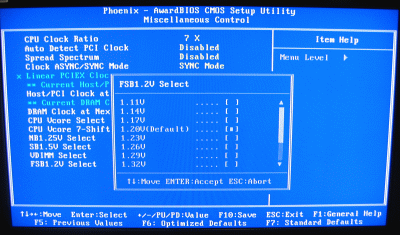
Click here for bigger version
Testbed:
Motherboard:
Jetway 966PDAG-PB (provided by dollarshops.eu)
Intel P965/iCH8
CPU:
Intel Core 2 Duo E6700 (provided by Intel)
CPU-Cooler:
Scythe Andy Samurai Master (provided by Scythe-Europe)
Memory:
Kingston 2GB kit PC2-9600U Kit KHX9600D2K2/2G (provided by Kingston)
CL5-5-5-15-CR2T at 1.82V
Graphics Card:
AMD ATI Radeon X1950XTX (provided by AMD)
Power supply:
Silverstone Element SF50EF-Plus (provided by Silverstone)
Hard disk:
Western Digital WD4000KD (provided by Ditech)
Case fans:
SilenX iXtrema Pro 14dB(A) (provided by PC-Cooling.at)
Scythe DFS122512LS
Benchmarks:
Gordian Knot/XVID 1.1.2:
For our Gordian Knot testing we took an PAL episode from "Babylon 5" with a length of 41 minutes, 57 seconds and 8 frames.
We tried to "emulate" the most common usage of Gordian Knot:
1st: We have a perfect master, so we only de-interlace the content and resize it, without any other manipulations, we marked this as "fast".
2nd: You get bad mastering on many DVDs, especially "old" stuff or when the studios are in a hurry for the release. In this case you like to improve the picture quality, which is done by filtering the content. You can choose from tons of filters for any purposes you can think of, we only used the most common "undot", "FluxSmooth" and "MSharpen". Of course we also de-interlaced, filters were done before any resizing took place (which is slower). We marked this as "slow".
If you need more infos about filters, we recommend reading the doom9.org forum.
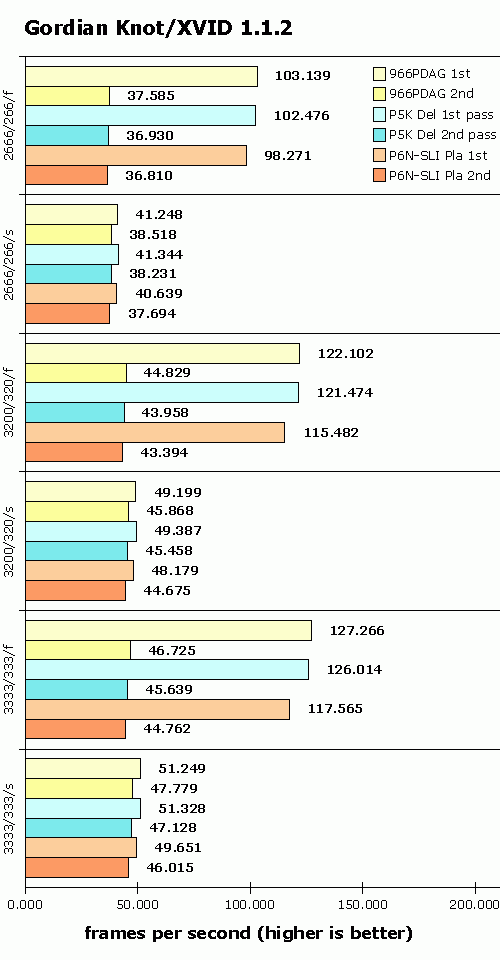
LameMT:
The same episode we encoded, we used for our MP3-testing. We don't recommend using MP3 for encoding, because AC3 can do the job better, but nearly 42 minutes gives us approximately the length of any given album.
A measurement in seconds, as many sites do, is useless, because the differences are too small. So we used the built-in play/CPU ratio, this means the CPU is encoding x-times faster then the track-length. Fast memory does not play an important role here. For your convenience we show you also the single-threaded benches, they will be produced with any other L.A.M.E. version, because only lameMT can do more than one thread and take advantage of a second dice.
We used this setting: lamemt --vbr-new -q 2 -V 2 -m j --strictly-enforce-ISO --resample 48
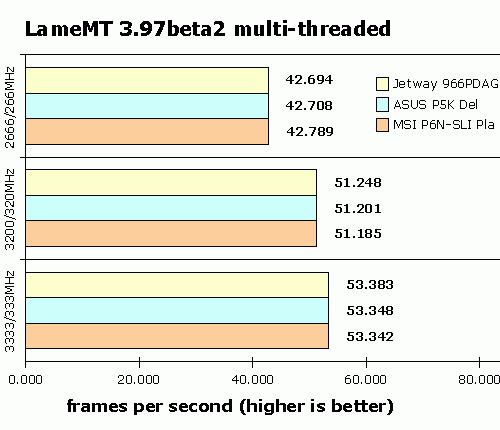
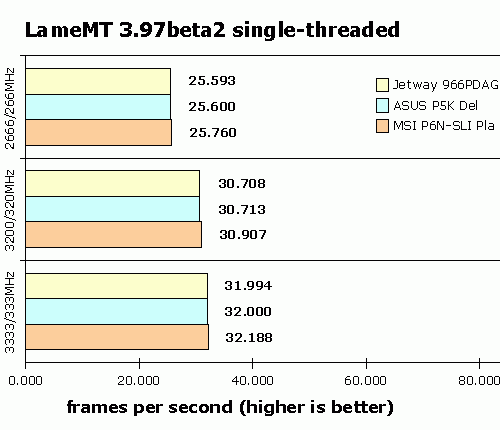
Conclusion:
Jetway did an amazing job. We have seen some "budget" boards, for example the MSI P35 Neo-F, but none of them were so easy to use. Despite the BIOS problems and the long response time from Jetway, the company managed to fix them. We don't know many companies they will take complaints seriously.
Normally vendors do not care of such things, because it's cheap and they will not invest money to improve any BIOS, except there is a serious bug and not even then, you can be sure it get fixed.
The next surprise was the speed of the board. This P965 board is slightly faster or on par with P35 boards. On top of this, Jetway uses solid capacitors, nowadays only found on expensive enthusiast boards. If you don't have lots of money, don't care about RAID - Windows/Linux can do software RAID anyways - and other fancy stuff, and you aren't an hardcore overclocker this board is just right for you and costs only half of comparable boards.
You can buy it for €73,- at dollarshops.eu.
